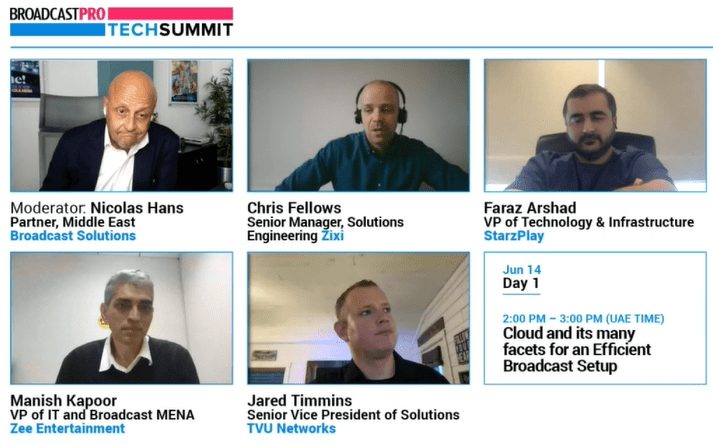
How has the pandemic affected cloud adoption in the broadcast media space? Zixi recently joined the BroadcastPro ME Tech Summit to discuss how cloud infrastructure is transforming media workflows in the Middle East and beyond.
It’s no secret that the shift towards remote workflows over the past year accelerated the need for broadcast organizations to virtualize their infrastructure and move workflows to the cloud. As part of BroadcastPro’s virtual Tech Summit, a group of industry experts from Zixi, Starz Play, Zee Entertainment and TVU Networks discussed how this transition to the cloud has enabled more efficient broadcast workflows, and why the cloud as an essential component of broadcast infrastructure that won’t be going away any time soon.
No Longer Bound to Outdated Workflows for Resilient, Reliable Delivery

When COVID-19 hit, panelists agreed that a lot of media workflows had to transform overnight and implementing cloud-based workflows allowed for the most flexibility in terms of remote monitoring and operations. Now, more than a year after initial transitions began, people are finding new ways to experiment need to utilize the cloud. Cloud-based infrastructure is easier to spin up, allows for the proliferation of content, and enables media companies to test new business models, a factor ever more important as media consumption habits continue to rapidly evolve. While it’s true the pandemic encouraged a faster transition to the cloud, it’s also true that many companies won’t go back to pre-COVID infrastructures thanks the the greater flexibility operators and content owners now have at their fingertips.
When adopting cloud infrastructure, the panelists noted that it is important to ensure resiliency with disaster recovery options that are secure and reliable. When asked what he would recommend to a broadcaster who wants to move a linear channel to the cloud, Zixi’s Senior Manager, Solutions Engineering Chris Fellows emphasized the importance of considering the right vendors, a seamless way to manage them from a centralized control plane, and the right protocol and streaming codec to keep compute costs as low as possible. “I think the first step would be to look at the different vendors that you can host with, and quite often our clients want redundancy across different vendors, and it’s quite important for our clients to have a simple user interface that spans all of those different cloud vendors as well. Look at the vendors, look at the different interfaces you can choose, and also looking at ways to reduce the compute requirement as well. In our world, we deal with live video streams, it’s all about the bandwidth of streams and the compute that you use in the cloud, and obviously the compute costs money, especially if you’re using big GPU instances, and so really by using a sensible streaming codec and streaming resolution and streaming protocol, you can certainly reduce that requirement and reduce the number of bills at the end of the quarter.”
Leverage Data to Improve Operations and Quality of Delivery
As part of the discussion, panelists acknowledged the increasing importance of data and its ability to help optimize broadcast media workflows. Today’s broadcasters need to know how to leverage their data to their advantage. While looking at video on a monitor wall can be helpful, it often reveals transmission issues only after they’ve become a problem and compromised stream quality. By closely monitoring and analyzing stream data, both historical and real-time, you can identify even prevent streaming transmission issues for a better quality of service and quality of experience.
“We have this conversation with broadcasters all the time. People still like to see video on a monitor wall, but you get more information from looking at the data of a stream rather than looking at the video.” Fellows explained. “Our Intelligent Data Platform can look at the RTT, look at the jitter on a network connection, look at all the different information and different PIDS inside a video stream, that’s all information you’re not going to be able to get from looking at a monitor wall. It’s also important to be able to use this data in a constructive way, putting it through machine learning and Artificial Intelligence to predict when a stream is in trouble or when a stream might go off air in the next 6 hours, for example.”
Impact Beyond Workflow Improvements to Economic Advantages
Panelists agreed that moving to the cloud presents not only a workflow and technology switch, but also transforms business operations by offering economical efficiency. Cloud-based solutions present an opportunity to reduce CapEx and infrastructure costs upfront and leverage an OpEx based model where costs are based on a recurring services standpoint. The moment you start showing the results of more efficient infrastructure, you’ll have a strong argument for delivering channels over IP cost-effectively and securely at scale. You can save costs in terms of satellite space, uplink costs, without the need to establish fiber networks, as its easy to broadcast content more efficiently over IP using the cloud.
Cloud-based solutions also present an economic advantage for occasional use events. Leveraging cloud infrastructure you can easily spin up cloud-hosted infrastructure as needed for temporary usage, allowing for streaming infrastructure that meets each customers’ individual need with adaptable, flexible technology solutions and service offerings that can revolutionize their business into the future by allowing them to scale up and down as needed using the cloud.
Not only is the cloud opening up new workflows and practices, but its allowing us to better operationalize and manage the data we’re capturing. Said Fellows, “We’re moving into a world where it’s all about data. For example, Zixi takes 3Bn data points a day from the video streams across out platform. You can’t get that kind of data from a traditional SDI and an infrastructure. It’s given us a lot more information, given our customers a lot more information, and we use that information to make our streaming more redundant and our service offering more valuable to our clients.” The additional data captured by software-defined solutions and cloud-based workflows allows for better customization of infrastructure, greater regionalization of content, and provides insights to help optimize for stream delivery at broadcast quality.
For broadcasters looking to move to the cloud, especially for those that want to go with a hybrid approach, there is a need to go beyond monitoring workflows and be able to to command and control them. “If you’re moving equipment to the cloud, there is a limitation on monitoring. You can’t just plug in an SDI cable to your multiviewer and monitor that. You need to monitor those linear streaming coming out from the cloud and monitor that software that’s in the cloud as well. If you’re using multiple protocols to send content, you want a decent control plane, a single platform to be able to monitor those streams, software applications, and hardware devices. You’re not going to want two monitoring planes and two control planes to monitor two separate systems. One of the major points to consider when virtualizing infrastructure is installing a system that can monitor and manage everything without needing to reinvent new solutions. That’s the challenge that we help clients overcome with Zixi’s ZEN Master, our cloud based control plane.”
Flexibility To Create New Revenue Paths
If this past year showed us that the cloud is about resiliency, panelists agreed that in the future, the cloud will be all about flexibility. Software-Defined Solutions allow for more flexible, agile broadcast infrastructure that complements cloud-based architectures. Instead of taking days to set up a new streaming infrastructure, it only takes minutes with the right software-based solutions. Working in the cloud enables greater network effects that will allow content providers and distributors beneficial flexibility when it comes to distributing and managing content.
“When we take streams up to the cloud and we’ve got streams already in the cloud, there’s a lot of ways broadcasters can utilize that” says Fellows. “They can distribute to head ends, or send content to different clients, or take that stream and sent it out to OTT, or send it to a CDN. The cloud gives you the greatest flexibility in terms of distribution points. And also you’re not limited in the hardware you have at your facility, or the ISP, or the bandwidth that you’ve got coming to your facility. Clients are a lot braver now with pop up channels, they could pop up streams and test streams out and try new things with streams that maybe they weren’t as brave with in the past. So there are lots of revenue paths available when you get streams up in the cloud, and lots of ways Zixi can help our clients do this, including Zixi as a Service where they can leverage all the benefits of the SDVP and the cloud, without the need to manage infrastructure”
While panelists all agreed that it is unlikely that broadcast infrastructure will going back to pre-COVID days given the agility found in new software-defined, cloud-based solutions, they all agreed that whether hybrid, private or public models, cloud infrastructure will remain a driving force in broadcast media workflows today and in the future.
To learn more about Zixi’s solutions for virtualizing broadcast streaming infrastructure, please contact Zixi Sales.
To watch the panel session in its entirety, please visit BroadcastPRO Tech Summit.

